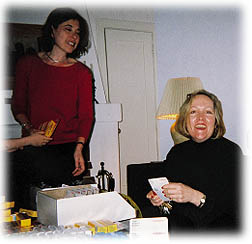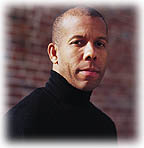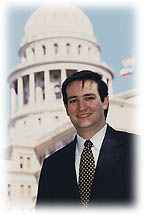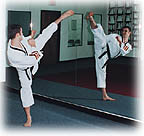 From the Archives
From the Archives
Class Notes - February 23, 2000
Class notes features
These undergraduates seem amused by what's going on in their classroom.
Taken in 1975, the photo might mislead viewers into thinking there were
no females on campus. However, records show that of the 4,396 undergraduates
enrolled at the time, 1,342 were women. As for the class these men are taking
and what's making them smile, one of paw's readers might be able to shed
some light.
A new old-girl network lures alumnae
Women-only events offer activities, including career seminars and
lessons in car mechanics
 When Liz Duffy '88 and a group of Princeton alumnae in New York City
first thought to gather fellow female graduates to discuss a community-service
initiative five years ago, they expected a couple of dozen people to turn
out. Eight times that number responded to the mailing and, having outsized
the capacity of its planned venue, the gathering spilled into the basement
of a church near Duffy's office. As the congregation of alumnae spoke out
with a similar refrain, the implication of the event was clear: Princeton
women missed each other after graduation. "They missed being at Princeton
where they were surrounded by a circle of smart women," Duffy explains
now, remembering the first meeting, "and they wanted serious activities
that spoke to where they were personally or professionally."
When Liz Duffy '88 and a group of Princeton alumnae in New York City
first thought to gather fellow female graduates to discuss a community-service
initiative five years ago, they expected a couple of dozen people to turn
out. Eight times that number responded to the mailing and, having outsized
the capacity of its planned venue, the gathering spilled into the basement
of a church near Duffy's office. As the congregation of alumnae spoke out
with a similar refrain, the implication of the event was clear: Princeton
women missed each other after graduation. "They missed being at Princeton
where they were surrounded by a circle of smart women," Duffy explains
now, remembering the first meeting, "and they wanted serious activities
that spoke to where they were personally or professionally."
Rising from its humble beginnings in the basement of the New York City church, the Princeton Women's Networks have since stretched across the country and drawn many alumnae back into the fold. Independently initiated by alumnae in New York, Boston, Los Angeles, and San Francisco, the networks offer activities or services geared toward a widening spectrum of Princeton women-a panel on career changes, an introduction to car mechanics, a presentation by a NASA astronaut on her experience aboard the Mir space station, discussions on balancing career and family, a directory that provides profiles of the members. "People tend to be busy and not interested in attending a random cocktail party to meet random people," says Duffy. "But they are willing to take two hours out to go to an event that will impact their professional lives."
Just as recent graduates may feel most comfortable attending Princeton events geared toward younger alumni, many alumnae may find events targeted to only women more appealing. "This is a group of women who said, 'Yes, we want an old girls' network,'" says Adrienne A. Rubin '88, associate director for class and regional affairs at the Alumni Council, who was also at the first meeting. It provides "an outlet for women." For those who have had little contact with Princeton since their departure through the FitzRandolph Gate, this involvement may also rekindle a contact with the university.
The Alumni Council provides access to regional lists and mailing labels, but the networks remain financially and organizationally independent. Most of the networks, however, require members to join a regional club first. That West Coast participants must join the Princeton Clubs of Northern or Southern California offers a bonus to the clubs. "We have attracted a good number of women who have helped revive the PCSC and make it more accessible to a broader range of people," says Alisa A. Matlovsky '76, one of the founding members of the Los Angeles branch.
There have been rumblings from women interested in starting a network in Philadelphia, and the foundations laid in other cities will make the task easier. For more information, contact: Davina J. Askin '91 in New York at 212-799-9788; Vickery Kehlenbeck '75 at 617-557-5942 in Boston or vkehlenbec@bost.rc.com; Alisa Matlovsky in Los Angeles at 323-938-3118 or dottedline@compuserve.com; Tamar Laddy '94 in San Francisco at tamar@women.com; or Adrienne Rubin at the Alumni Council at 609-258-5844.
-Hilary Roxe '97
Vases as buildings
Ken Wingard '86 designs objects from an architect's perspective
 Two years ago, Ken Wingard '86 quit a successful career
in retail at Pottery Barn and retired to his bedroom with his laptop. There,
he began to design small household items-vases, candleholders, frames, and
lamps that were elegant, functional, and affordable. Today, his Wingard
Home Furnishings Company has 200 original products in 600 stores across
the U.S. and in Europe. Retail outlets include Restoration Hardware, Barney's
of New York, Crate and Barrel, The Museum of Modern Art in New York, and
Starbucks. (In Princeton, Go for Baroque carries some of his items.) He
does all the wire accessories for Martha Stewart and is designing accessories
for W Hotels, a trendy new chain for businessmen. He has also just launched
his first furniture line, his first fabric, and his first e-commerce site,
at www.wingardinc.com. He will soon open his first store.
Two years ago, Ken Wingard '86 quit a successful career
in retail at Pottery Barn and retired to his bedroom with his laptop. There,
he began to design small household items-vases, candleholders, frames, and
lamps that were elegant, functional, and affordable. Today, his Wingard
Home Furnishings Company has 200 original products in 600 stores across
the U.S. and in Europe. Retail outlets include Restoration Hardware, Barney's
of New York, Crate and Barrel, The Museum of Modern Art in New York, and
Starbucks. (In Princeton, Go for Baroque carries some of his items.) He
does all the wire accessories for Martha Stewart and is designing accessories
for W Hotels, a trendy new chain for businessmen. He has also just launched
his first furniture line, his first fabric, and his first e-commerce site,
at www.wingardinc.com. He will soon open his first store.
The former Princeton architecture major and his 10 employees work in a large single-room office with high ceilings and whitewashed walls in the hip South Park neighborhood of San Francisco. Dressed in black and dark gray, Wingard is as elegant as his products. Picking up a vase that sells for $19.50 and whose brushed nickel-plated surface softens the light it reflects, Wingard thinks of his designs as "modernism possessed of the elegance and grace of our humanity without the clutter of our lives."
 Born in Savannah, Georgia, Wingard decided at Princeton
that architects don't make much money and that he was more interested in
design. "Princeton architecture is so theoretical you couldn't build
a tree house afterwards, but thank God I took architecture. I learned how
to analyze buildings. I never use my physics, or chemistry, but I can look
at a building and understand the space and shape, the geometry and psychology
behind it. I reduce buildings to objects. This vase-it's a tiny building,
for a table or a desk."
Born in Savannah, Georgia, Wingard decided at Princeton
that architects don't make much money and that he was more interested in
design. "Princeton architecture is so theoretical you couldn't build
a tree house afterwards, but thank God I took architecture. I learned how
to analyze buildings. I never use my physics, or chemistry, but I can look
at a building and understand the space and shape, the geometry and psychology
behind it. I reduce buildings to objects. This vase-it's a tiny building,
for a table or a desk."
After Princeton, and a short stint in retailing, he traveled for two years in Europe and Africa. In Zanzibar he designed his first product, picture frames made out of mango wood that he strapped to his backpack and carried home. A friend's wedding that winter took him to San Francisco. "It was a sunny, balmy day, and I asked myself, 'Why am I living back East?' I took the only retail job available, as a telephone operator for Pottery Barn. At the time, Pottery Barn had 22 stores. Eight years later, it had 100 stores, and I was buying accessories for half of them, traveling abroad annually to decide the Pottery Barn look for the next year."
 Wingard still travels regularly: to Asia to check on the factories that
make his products, and to New York and Europe to look at ready-to-wear clothes,
which are "a good predictor of home furnishings. I'm launching a line
of pastel products this spring because color is sneaking back in."
Wingard still travels regularly: to Asia to check on the factories that
make his products, and to New York and Europe to look at ready-to-wear clothes,
which are "a good predictor of home furnishings. I'm launching a line
of pastel products this spring because color is sneaking back in."
Success has minimized the time he has for design. But, he says, "I would be bored just doing design, or just business. Princeton was great in that way-I learned to hold several opposing ideas and projects in my mind at the same time."
In his spare time, he is renovating a 1904 Edwardian house. "Everyone thinks that because I'm a designer, I must have a cool house. Right now, it's a pit. My dog rules, and my architect hates me because I know something about architecture."
-Dan White '65
Dan White '65, former director of the Alumni Council, is a consultant in alumni relations and a freelance writer.
All-nighters with George W. Bush
Ted Cruz '92 believes in "compassionate conservatism"
 As a domestic policy adviser to Republican presidential candidate George
W. Bush, Ted Cruz '92 puts in long hours. But working well into the night
for a powerful figure is nothing new for Cruz: In 1996 and 1997, he clerked
for Supreme Court Chief Justice William Rehnquist.
As a domestic policy adviser to Republican presidential candidate George
W. Bush, Ted Cruz '92 puts in long hours. But working well into the night
for a powerful figure is nothing new for Cruz: In 1996 and 1997, he clerked
for Supreme Court Chief Justice William Rehnquist.
Cruz, a Harvard Law School graduate and a former clerk on the U.S. Court of Appeals in Richmond, Virginia, was one of three Rehnquist clerks that session.
"A typical day was pretty all-consuming," he says. Clerks would often work from about 9 a.m. to 1 a.m., but all-nighters were routine, helping out with almost every aspect of the court, including writing first drafts of opinions. For Rehnquist's trio of clerks, the job description even includes required Thursday-morning tennis matches with the boss.
Cruz continued his legal career by joining Cooper, Carvin & Rosenthal, a small Washington firm. For two years, revolving-door rules barred Cruz from working on Supreme Court cases-the firm's specialty-so Cruz helped represent Representative John Boehner, a Republican from Ohio, in a pending federal lawsuit, and he also helped Ford Motor Co. in a winning $10-million appeal.
At Princeton Cruz studied at the Woodrow Wilson School, chaired the U-Council, and won national championships as a debater for Whig-Clio, but he had never worked in electoral politics before last July, when he joined the Bush campaign to work for policy director Josh Bolten '76. Cruz had grown up in Houston; his mother and father, both mathematicians, were, like Bush himself, in the oil-exploration business, though the two families' paths never crossed.
"One of the reasons I was so eager to help Bush is the way he has described himself, as a compassionate conservative," Cruz says. "That's how I have always conceived of my own political views."
Cruz's portfolio includes a wide variety of legal issues-including judicial appointments, criminal justice, and constitutional law-as well as immigration and campaign finance reform. As the son of a Cuban exile, Cruz advises Bush on Hispanic affairs, and he's also worked extensively on school-choice policy.
By now, Cruz has perfected the politician's answer on whether he would join a Bush administration. "I would
certainly be interested in exploring it," he says. "But I want to focus on the task at hand: getting the nomination and winning the election."
-Louis Jacobson '92
Louis Jacobson covers lobbying and politics for National Journal.
Learning to kick back
Eric Albrecht '97, a martial arts champ, now teaches others how to
fight
 When Eric Albrecht '97 was just starting to practice the Korean martial
art Tae Kwan Do he was, by his own admission, "a terrible fighter."
A shy boy who preferred the highly technical noncontact part of the competition,
known as "forms" to actual fighting, Albrecht remembers that when
it came to sparring, "I would always get my butt kicked-without fail."
Certainly not the background one expects for a five-time world champion
in his sport.
When Eric Albrecht '97 was just starting to practice the Korean martial
art Tae Kwan Do he was, by his own admission, "a terrible fighter."
A shy boy who preferred the highly technical noncontact part of the competition,
known as "forms" to actual fighting, Albrecht remembers that when
it came to sparring, "I would always get my butt kicked-without fail."
Certainly not the background one expects for a five-time world champion
in his sport.
"I was 15 or so when my instructor told me he was moving me up an age group one year early," Albrecht remembers. The news was not particularly welcome, he admits, as the next-highest age group encompassed everyone between 16 and 32 years of age. "Because I was so outweighed, I had to start running for my life," he says, laughing.
The switch didn't pay immediate dividends, but gradually, Albrecht says, he stopped losing all his fights and began to win a few. Then, "almost overnight," things changed drastically. He became comfortable with the speed of the bouts and reached a point where "I could see things sooner and more clearly."
When he was 18, Albrecht entered the world championships (held every year in Little Rock, Arkansas) and fought his way into the age-group title bout, only to "fall apart," in his own words, and miss his shot at becoming the youngest champion ever. The next year, Albrecht remembers, "I said to myself, no one is beating me, no one is stopping me," and he mowed through the competition to take the championship. After losing again in 1994, Albrecht returned to take four consecutive titles from 1995 to 1998. In the 1999 championship he lost in a late round to the eventual winner.
When someone asks Albrecht who was his mentor in the sport, he skips over many of the instructors he worked with as a young fighter and jumps straight to Master Ji Ho Choi, who runs the Princeton Tae Kwan Do club. "He turned me into a much better fighter," says Albrecht, "and he also helped me learn how to teach sparring. He is the best I have ever seen at teaching someone to spar."
This last point is important, because it gave Albrecht the background he needed to found ATA Black Belt Academy in Belle Mead, New Jersey. The two-year-old academy already has 220 students, and has earned Albrecht recognition from the American Tae Kwan Do Association as one of the fastest-growing schools in the country. Albrecht runs the school while attending medical school part-time at the nearby University of Medicine and Dentistry of New Jersey. The combination is, he admits, "a bit of a lunatic idea." But one imagines that he has won tougher battles.
-Rob Garver
GO TO the Table of Contents of the current issue
GO TO
PAW's home page